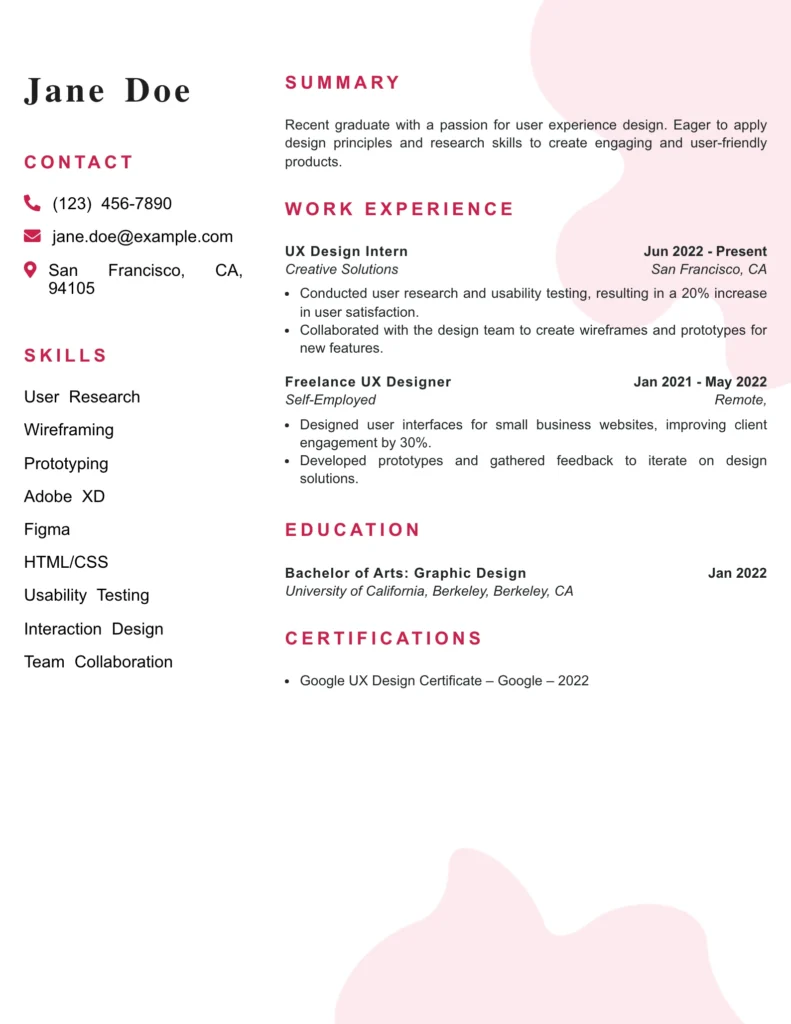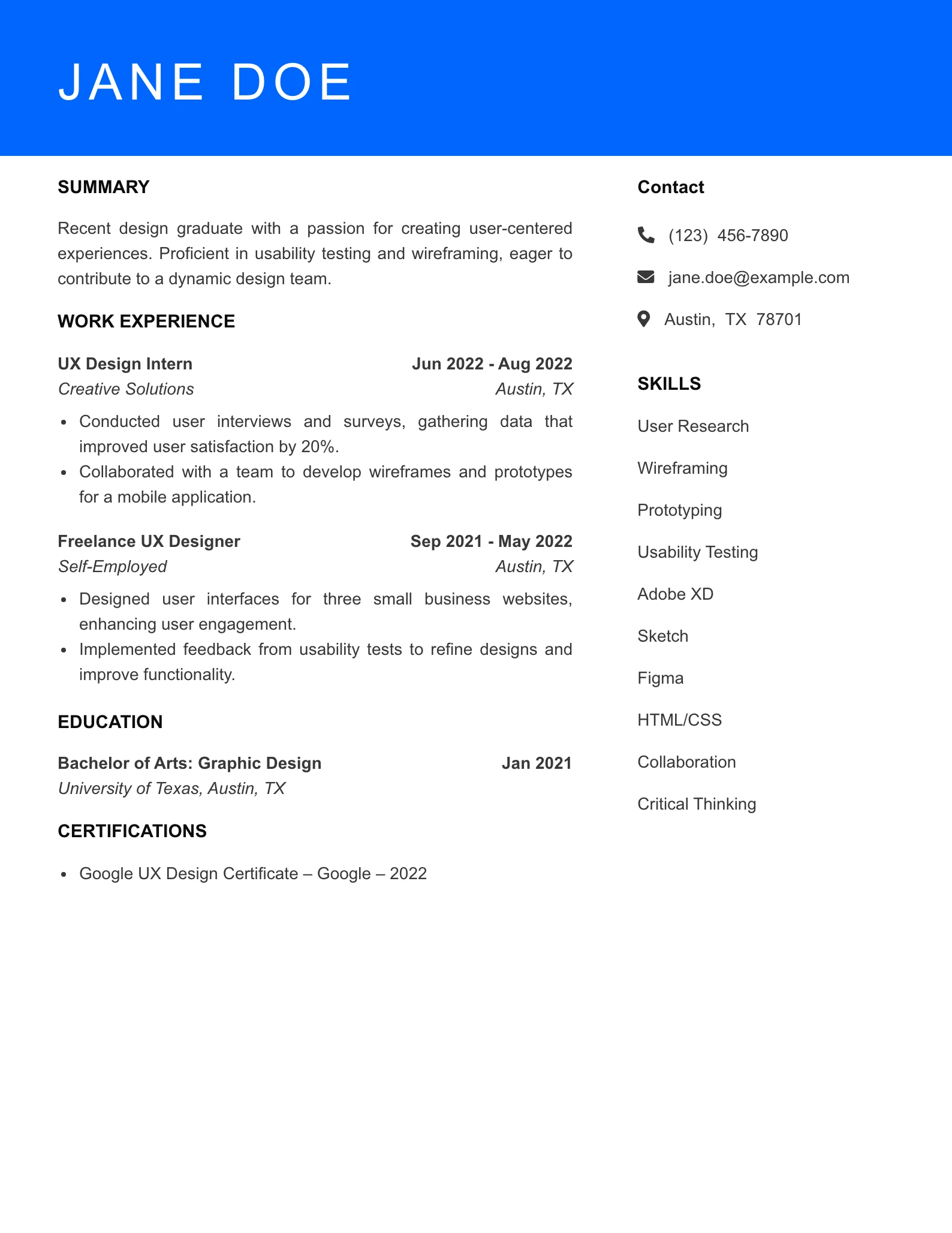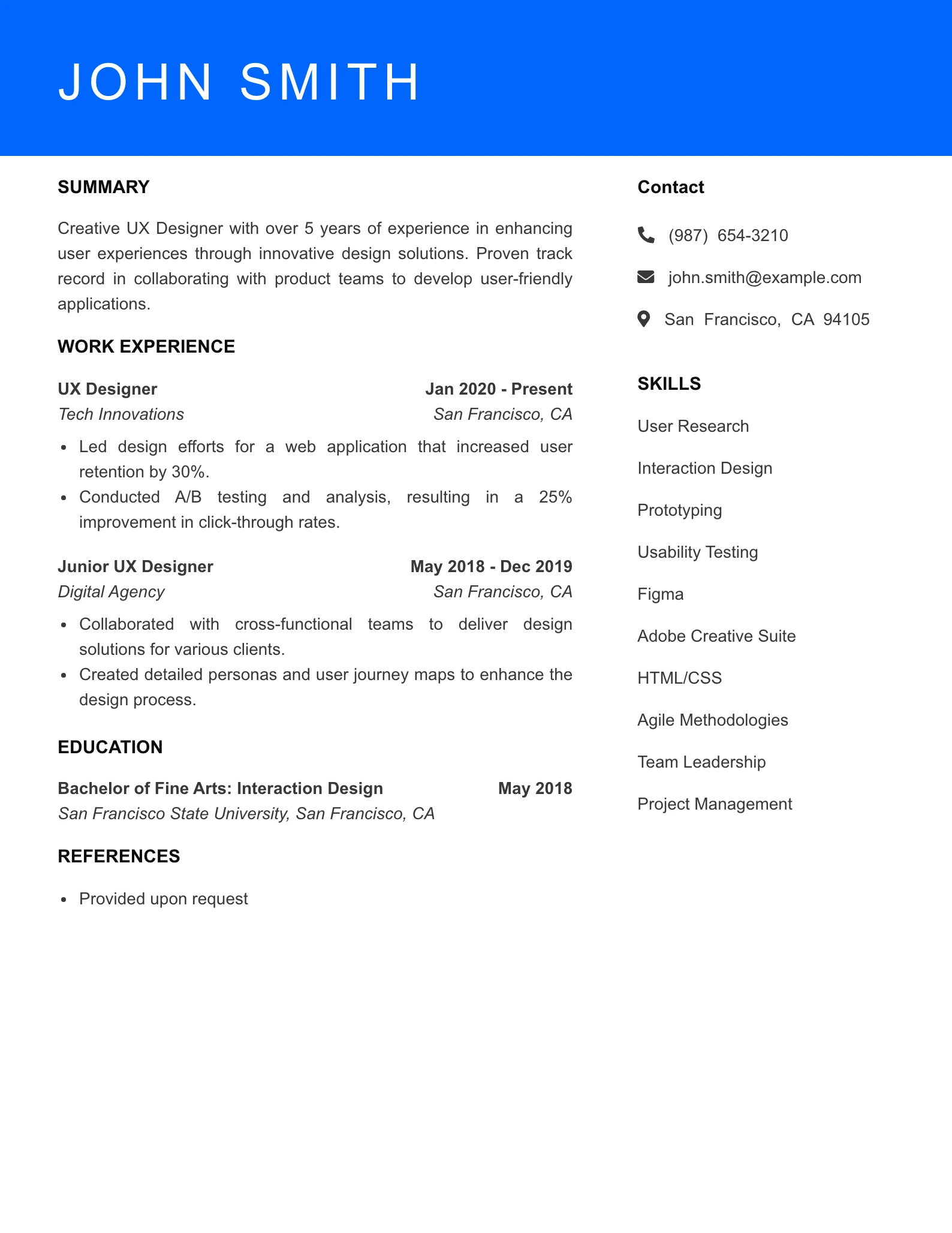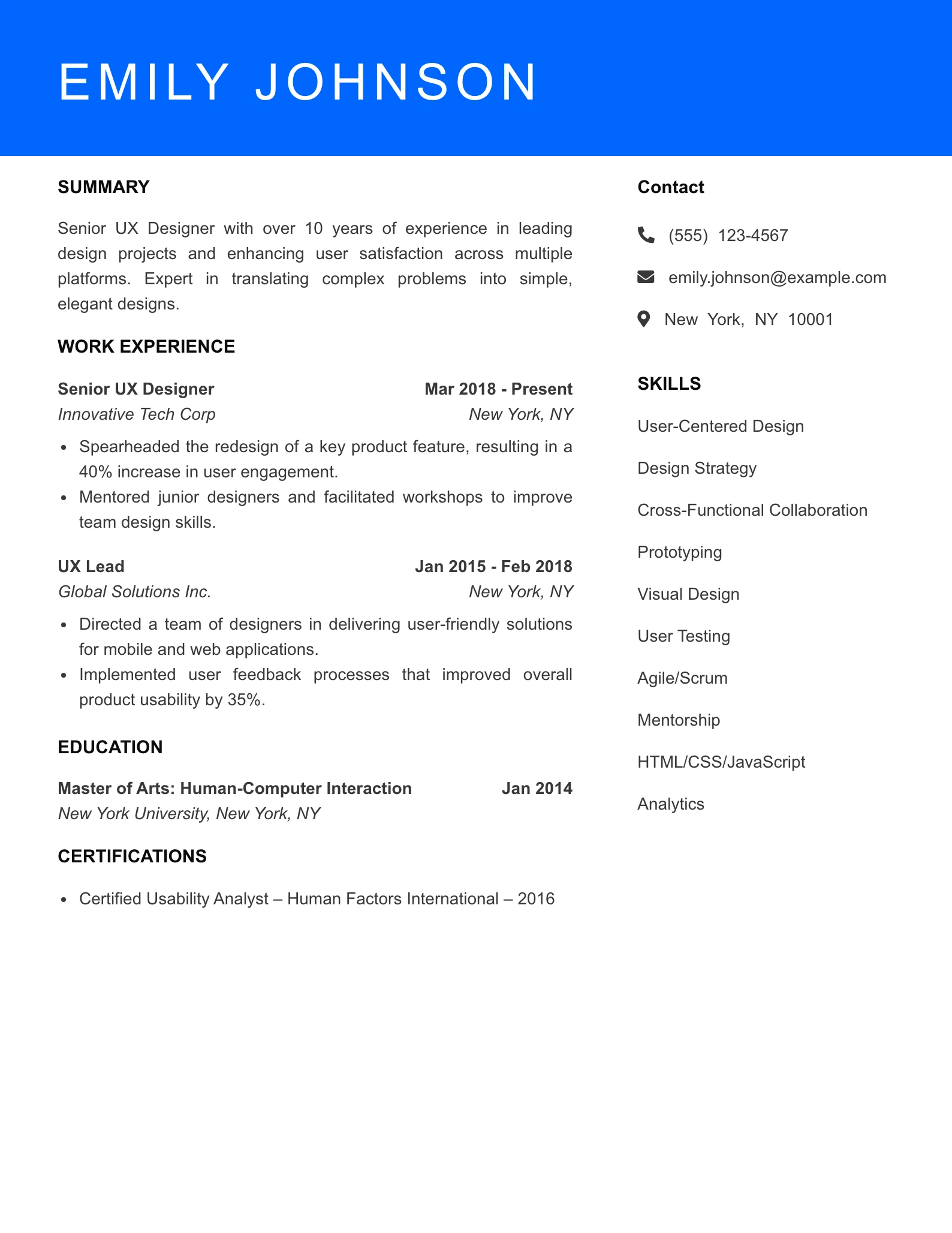Want to create a UX designer resume that lands you a job? This guide will teach you how to showcase your skills effectively, format your work experience, and avoid common pitfalls. Read on to learn the key elements of a winning resume.
Key Takeaways
A strong UX designer resume should effectively showcase skills, experiences, and achievements in a clear, structured, and relevant manner to catch the attention of hiring managers.
Key components of a UX designer’s resume include contact information, work experience, education, skills, and optionally, a short bio, all laid out in an intuitive, visually appealing format.
Tailoring your resume to specific job descriptions, highlighting quantifiable results, and avoiding common formatting mistakes are essential strategies for enhancing the effectiveness and readability of your resume.
What Makes a Strong UX Designer Resume?

Creating a standout UX designer resume is about more than just listing your previous jobs. It’s about presenting your skills, experiences, and achievements in a way that tells a coherent story. Clarity, relevance, and demonstration of skills are crucial elements that can make your resume shine. A well-structured resume should clearly present sections like experience, skills, and education to enhance readability and ensure that hiring managers can quickly find the information they need.
Employers appreciate concise resumes that effectively summarize your experiences and skills. To increase your chances of getting noticed, consider the following tips:
Tailor your killer resume according to the specific job description to highlight the most relevant parts of your background.
Use relevant keywords and skills to help your resume pass initial screenings.
Ensure your resume stands out among other applicants by focusing on these key elements.
Remember, proper formatting and a clean design can make a significant difference in how your resume is perceived. A relevant and easy-to-read hierarchy aids in the quick assessment of your resume by hiring managers. Keeping the length of your UX designer resume to one page is often recommended to maintain clarity and avoid overwhelming the reader with too much information.
Focusing on these key aspects will help you create a resume that highlights your qualifications and demonstrates your understanding of design thinking principles and user-centered design principles.
Key Components of a UX Designer’s Resume
A well-crafted UX designer resume should be intuitive, visually appealing, and easy to navigate, much like a well-designed user interface. The essential components of a UX designer’s resume include:
Contact information
Work experience
Education
Skills and tools
Optionally, a short bio Each of these elements plays a crucial role in painting a comprehensive picture of your professional journey.
Combining these components with general guidelines strengthens your resume, making it a powerful tool in your job search. Each of these components will be detailed further to help you build a standout resume.
Contact Information
Your contact information is the first thing hiring managers will look at, so it needs to be clear and easy to find. Include essential details such as:
Your full name
Phone number
Email
LinkedIn profile
A link to your portfolio.
To make your contact details easily visible and showcase your UX work effectively:
Format your contact details for easy visibility.
Ensure that your name and links stand out.
Present your portfolio link prominently to showcase your UX work from the start.
Work Experience
The work experience section is where you highlight your professional journey. Here are some tips for listing your work experience:
List your work experience in reverse chronological order to help employers quickly identify your most recent qualifications.
Focus on relevant work experience that showcases your skills and contributions in UX design.
Omit unrelated positions, as including them can distract from your qualifications.
Showcase your career progression and relevant experiences to highlight your job title, growth, and leadership abilities.
Maintain clarity and consistent formatting to enhance readability in the same company.
Entry-Level:
UX Intern, Creative Solutions, Boston, MA, June 2022 – Aug 2022
– Conducted user research and usability testing for a new mobile app
– Assisted in creating wireframes and prototypes using Figma
– Collaborated with design teams to refine user interfaces
Mid-Level:
UX Designer, Innovate Tech, San Francisco, CA, Jan 2018 – Present
– Led user experience design for multiple high-impact projects, resulting in a 25% increase in user engagement
– Conducted A/B testing to optimize user pathways and improve conversion rates
– Mentored junior designers in best practices for user-centered design
Education
Your educational background is a vital part of your resume. When listing it, consider the following:
Start with the most recent program.
Include details about your university studies.
Mention relevant courses.
Highlight any notable certificates.
Include UX bootcamps and online courses, as they demonstrate your proficiency in design principles through the projects undertaken during these programs.
Achievements like certificates from completed courses or bootcamps effectively showcase your skills.
Template:
Degree, Major, School Name, City, State, Graduation Year
Example:
BA, Graphic Design, California State University, Los Angeles, CA, 2020
Certificates:
Google UX Design Professional Certificate – Coursera – 2021
Nielsen Norman Group UX Certification – 2022
Skills and Tools
The skills and tools section is where you list the key skills that make you a great UX designer. Important skills include prototyping, research, user testing, coding, and visual design. Categorize your skills if needed and avoid flashy indicators; instead, use clear terms like intermediate or advanced to indicate tool proficiency levels. Listing tools and skills in a logical order significantly enhances the readability of your resume.
Successful UX designer resumes should emphasize:
Core technical skills, such as user research and wireframing
Essential soft skills like empathy and problem-solving
Familiarity with design skills and design tools like Adobe XD and Sketch
UX design skills in user testing and UX methodologies
Top ATS Keywords for UX Designer
| Skill | Frequency |
|---|---|
| User Research | 184 |
| Wireframing | 161 |
| Prototyping | 138 |
| Usability Testing | 115 |
| Interaction Design | 115 |
| Visual Design | 92 |
| Information Architecture | 92 |
| Design Thinking | 69 |
| Figma | 69 |
| Adobe XD | 69 |
By prioritizing the most relevant skills, you can present a strong case for your capabilities.
Short Bio (Optional)
A short bio is optional but can significantly enhance your resume by highlighting your unique qualities as a UX designer. The bio should showcase your attitude towards UX design, expertise, and key skills relevant to the job.
To write an effective resume bio, review UX designer job postings and draw inspiration from the language used.
Examples of Winning UX Designer Resumes

Sometimes, the best way to learn is by example. Reviewing winning UX designer resumes can provide inspiration and a clear idea of what a successful resume looks like. These examples can help you understand how to present your own experiences and skills in a way that stands out to hiring managers.
In the following subsections, we will explore examples of entry-level, junior, and senior UX designer resumes, including resume examples. By studying these examples, you can enhance your resume and improve your chances of landing your dream job.
Entry-Level UX Designer Resume
For entry-level UX designers, it’s essential to emphasize:
Relevant internships and projects to demonstrate relevant experience.
Projects related to the job description to enhance relevance in your resume.
Educational achievements, methodology, and skills to make a strong impression.
If you lack work experience, consider including the following in your online portfolio:
Free-time design works or pro bono projects to demonstrate your motivation for professional improvement through self-training.
Relevant internships.
Freelance projects and personal projects to showcase practical experience.

Why This Resume Works
- The summary clearly articulates Jane’s recent graduation and passion for user experience design, effectively setting the stage for her qualifications and career aspirations.
- Relevant skills are explicitly listed, showcasing a strong foundation in UX design tools and methodologies that align well with industry expectations.
- The work history highlights impactful contributions, such as measurable increases in user satisfaction and client engagement, demonstrating Jane’s ability to deliver results.
- The resume is suitable for an entry-level position, as it emphasizes relevant internships and freelance work, illustrating practical experience in the field.
- Overall clarity and a professional tone enhance the resume, making it easy for hiring managers to quickly assess her qualifications and fit for a UX design role.
Junior UX Designer Resume
Quantifiable results such as task success rates, error rates, and user satisfaction scores should be highlighted to demonstrate your impact as a junior UX designer. A colorful design can make your resume stand out among others and attract the attention of hiring managers.
A personal bio in your resume conveys your unique UX design attitude, expertise, and skills. Measurable accomplishments like improved user retention and successful product launches are vital in a junior UX designer’s work history.

Why This Resume Works
- The summary is clear and directly highlights John’s experience in user-centered design, establishing his qualifications for the role effectively.
- The skills section is relevant and comprehensive, showcasing a mix of technical and soft skills that align with the demands of a UX Designer position.
- The work history demonstrates impactful contributions, such as a significant increase in user retention and successful product launches, reflecting John’s ability to drive measurable results.
- The resume is well-suited for a mid-level position, showcasing over 5 years of experience and a progression from Junior UX Designer to a leadership role, indicating readiness for increased responsibility.
- The clarity and professional tone throughout the resume enhance its overall effectiveness, making it easy for hiring managers to assess John’s qualifications and fit for the role.
Senior UX Designer Resume
A senior UX designer resume should:
Be easily readable and organized for clarity.
Utilize segmented resumes with line breaks to create visual blocks of related data, enhancing readability.
Emphasize extensive experience and expertise.
Showcase yourself as a results-driven senior product designer professional.
To enhance your resume, consider the following tips:
Showcase quantifiable achievements related to user engagement and conversion rates to demonstrate your effectiveness.
Include notable work experience, such as web design for iconic brands, to set yourself apart.
Organize your resume with bolded, colorful headings to make key segments easy to identify. For additional guidance, see examples of objectives for resume for freshers.

Why This Resume Works
- The summary clearly articulates Emily’s extensive experience and expertise in UX design, positioning her as a results-driven professional suited for senior roles.
- A comprehensive list of relevant skills aligns closely with industry standards, showcasing her capabilities in both design and leadership, essential for a senior marketing role.
- The work history highlights quantifiable achievements that demonstrate her impact on user engagement and conversion rates, underscoring her effectiveness and success in previous positions.
- The progression of her roles from UX Designer to Senior UX Designer indicates a strong career trajectory, affirming her suitability for senior-level positions in marketing or UX design.
- The clarity and tone of the resume are professional and confident, effectively communicating her qualifications and making a strong impression on potential employers.
Writing Tips for Crafting Your Own UX Designer Resume

Crafting your own UX designer resume involves:
Summarizing your experiences, education, skills, and accomplishments effectively.
Highlighting relevant experiences and skills prominently to direct the reader’s attention.
Using professional templates to streamline the resume creation process by providing structured layouts and design elements.
Many professional templates are tailored specifically for UX roles, including sections that highlight relevant skills and experiences for ux professionals. Maintain a single-page format for your ux designer resume template to keep it concise and relevant.
Tailoring Your Resume to Job Descriptions
Tailoring your resume to the job description is crucial for UX designers. To ensure your resume stands out, consider the following:
Strategically include relevant information within a limited space.
Include specific keywords and information relevant to the job posting.
Enhance your chances of passing initial screenings by aligning your resume with the job requirements.
Referencing job descriptions can guide the creation of a compelling resume header that aligns with employer expectations. Utilize descriptive keywords from the job posting to make your resume stand out. Employers often appreciate resumes that reflect a candidate’s familiarity with their unique design vision.
Highlighting Quantifiable Results
Employers prefer to see metrics that demonstrate the real-world impact of a UX designer’s work. Quantifiable results are crucial in showcasing the effectiveness of your design work, including usability testing, user flows, user centered designs, user interviews, and the system usability scale. Examples of metrics to include are success rates, user satisfaction scores, and retention metrics.
Candidates should strive to quantify their achievements in their resumes to stand out to hiring managers. Demonstrating these metrics can provide concrete evidence of your contributions and the value you bring to a team.
Prioritizing Information Logically
Prioritizing information logically allows hiring managers to quickly scan important details. Listing work experience in reverse chronological order enhances clarity and provides a clear timeline of your career. Focusing on relevant and recent experience ensures that you present your best qualifications for the position you’re applying for.
Common Mistakes to Avoid in UX Designer Resumes

Common mistakes in UX designer resumes include formatting issues that make them harder to read, leading to potential rejection by hiring managers. A well-organized and easy-to-navigate resume helps avoid this pitfall. Including overly creative job titles and exhaustive team project lists can dilute the clarity of your resume; focus on your individual achievements to make a stronger impact.
Lack of metrics on results can make your achievements seem less impactful. Always include quantifiable outcomes where possible to demonstrate your effectiveness. Avoiding these common mistakes helps create a resume that truly stands out.
Designing for Readability and Usability
Creating a visually appealing resume improves the reader’s experience, much like graphic design for digital users. Here are some tips:
Opt for clean and straightforward fonts to ensure easy reading.
Utilize a PDF format to avoid formatting issues across devices.
Incorporate color sparingly, using mainly black text to enhance readability in both digital and print formats.
Whitespace is essential for making resumes inviting and aiding in the skimming of content. Implement well-structured content in your resume, which allows hiring managers to quickly assess qualifications.
Italics can make the resume appear busy and detract from its clarity, so it’s best to avoid them.
Using Professional Templates
Using professional templates can enhance the visual appeal and consistency of your UX designer resume. Many downloadable resume templates are available online, offering comprehensive help with structure and content.
Utilize these templates to prototype and iterate on your resume based on feedback and testing. This process mirrors the iterative ux design process in UX, ensuring that your resume is both effective and visually appealing, especially when using interactive prototypes and rapid prototyping and applicant tracking systems.
Showcasing Your UX Design Portfolio

A standout UX designer resume serves as an introduction to potential employers and works in tandem with a design portfolio. An effective UX design portfolio tells a story that illustrates your interaction design process and thinking.
Include case studies that showcase your design methods, problem-solving skills, and impact metrics on user engagement. Prominent and clear presentation of your portfolio link enhances the likelihood of it being noticed by hiring managers. Consider using multiple placements for your portfolio link within your resume and cover letter to enhance its visibility.
UX Designer Resume Examples – Free Download




Text Resume Samples
Jane Doe
Level: Entry-Level
Location: San Francisco, CA 94105
Phone: (123) 456-7890
Email: jane.doe@example.com
Professional Summary
Recent graduate with a passion for user experience design. Eager to apply design principles and research skills to create engaging and user-friendly products.
Skills
- User Research
- Wireframing
- Prototyping
- Adobe XD
- Figma
- HTML/CSS
- Usability Testing
- Interaction Design
- Team Collaboration
Education
Bachelor of Arts in Graphic Design, University of California, Berkeley, Berkeley, CA, 2022
Work Experience
UX Design Intern – Creative Solutions
San Francisco, CA | June 2022 – Present
- Conducted user research and usability testing, resulting in a 20% increase in user satisfaction.
- Collaborated with the design team to create wireframes and prototypes for new features.
Freelance UX Designer – Self-Employed
Remote | Jan 2021 – May 2022
- Designed user interfaces for small business websites, improving client engagement by 30%.
- Developed prototypes and gathered feedback to iterate on design solutions.
References
Provided upon request
Certifications
- Google UX Design Certificate – Google – 2022
Summary
In summary, a strong UX designer resume is clear, concise, and tailored to the job description. It includes well-structured sections for contact information, work experience, education, skills and tools, and optionally, a short bio. Reviewing example resumes can provide valuable insights and inspiration.
By applying these tips and showcasing your UX design portfolio effectively, you can create a resume that stands out and helps you land your dream job. Remember, your resume is your first opportunity to make a lasting impression, so make it count.
Frequently Asked Questions
What should be included in a UX designer’s resume?
A UX designer’s resume should clearly include contact information, work experience, education, skills and tools, and a concise bio if desired. Tailoring it to the job description and integrating relevant keywords and metrics will make it more impactful.
How can I make my UX designer resume stand out?
To make your UX designer resume stand out, focus on clarity and structure, utilize professional templates, and showcase quantifiable achievements along with a prominent portfolio link. This approach will effectively highlight your skills and experience to potential employers.
What common mistakes should I avoid in my UX designer resume?
To enhance your UX designer resume, avoid formatting issues, overly creative job titles, and exhaustive team project lists. Instead, concentrate on showcasing individual achievements and present your information clearly for better readability.
How important is a portfolio link in a UX designer resume?
A portfolio link is essential in a UX designer resume, as it showcases your work and allows hiring managers to evaluate your skills and design process effectively. Ensure it’s prominently displayed for easy access.
Should I include a short bio in my UX designer resume?
Including a short bio in your UX designer resume can enhance its effectiveness by highlighting your unique qualities and relevant skills. This optional addition helps you convey your attitude towards UX design more clearly to potential employers.








